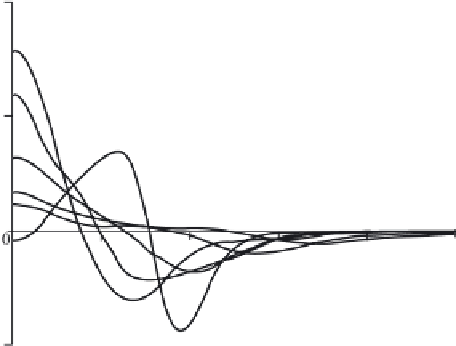Geoscience Reference
In-Depth Information
Equation (3.76) was approximated by the explicit finite difference scheme. At
the boundaries of the calculation region the condition of free passage was realized,
∂ξ
∗
∂
∓
∂ξ
∗
∂
=
.
(3.77)
t
∗∗
x
∗
and
s
, determining the function
Q
∗
, are a result of averaging
Since the fields
Φ
t
∗
= 4, the output of the model (3.4)-(3.6) was the discrete
over the time interval
∆
set:
Q
∗
(
x
∗
,
n
t
∗
), where
n
= 1
,
2
,
3
,...
. In passing to resolve the problems (3.76) and
(3.77) the step in space
∆
t
∗∗
were
mad
e to comply with each other as follows: within the time interval
t
∗∗
f
rom
0
x
∗
remained the same, while the time steps
t
∗
and
∆
∆
∆
to 4
√
g
H
/
c
function
Q
∗
(
x
∗
,
4) was in force, within the time interval from 4
√
g
H
/
c
to 8
√
g
H
/
c
it was
Q
∗
(
x
∗
,
8) and so on.
The main part of numerical experiments was carried out for values of the
dimensionless parameters, corresponding to
H
= 4km,
L
= 20, 40 and 80 km,
0
.
26
<
z
= 20 m. The horizontal step
was chosen to be such that 100 nodes could occupy the length
L
of the source
(
τ
<
26 s. The vertical step amounted to
∆
x
= 200
,
400 and 800 m). The time step was determined by the Courant condi-
tion
∆
t
= 0
.
009 s was applied.
Figure 3.26 presents the typical time behaviour of function
Q
∗
(
x
∗
), reflecting
the action of a 'non-linear tsunami source'. The highest absolute values of
Q
∗
(
x
∗
)
are not achieved immediately, but only after the passage of a certain time (
t
∗
= 8
in the example considered), upon which the intensity of the 'non-linear source'
decreases monotonously, which is explained by elastic waves leaving the region
where deformation of the ocean bottom occurred. It is important to note that the time
the non-linear source is in action noticeably exceeds the duration of the ocean bot-
tom displacement.
∆
t
<
∆
z
/
c
. In calculations the step
∆
Fig. 3.26 Characteristic form of function
Q
∗
(
x
∗
,
t
∗
). Curves 1-6 correspond to
t
∗
= 4, 8, 12, 16,
20, 24. The source parameters:
τ
= 8s,
L
= 40 km,
H
= 4km

















